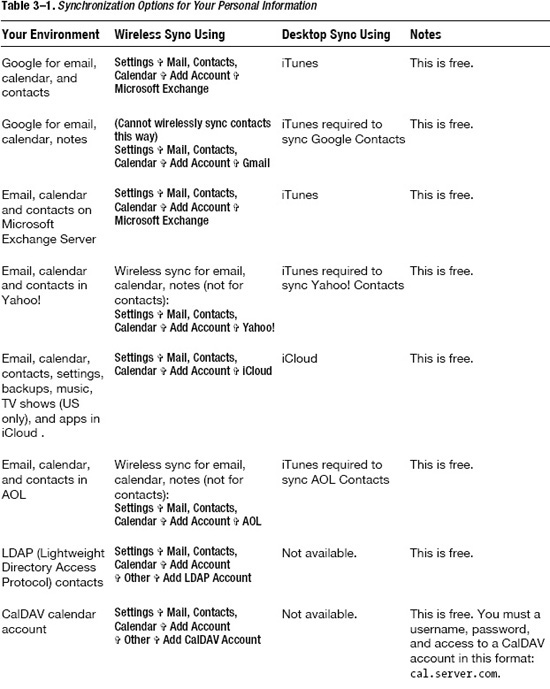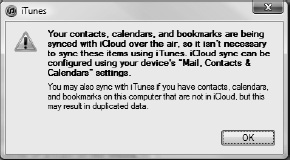Chapter 3
Sync with iCloud, iTunes, and More
In this chapter, we will show you how to set up or adjust your storage and push your information to Apple’s new iCloud service, as well as how to synchronize information between your iPhone and your Windows or Mac computer using iTunes.
With iCloud, you can wirelessly sync your mail, contacts, calendars, reminders, bookmarks, notes, photos, and documents and data, as well as back up your iPhone wirelessly over-the-air (OTA). With iTunes, you can sync or transfer contacts, calendar, notes, apps, music, videos, iBooks, documents, and picture libraries, as well as back up your iPhone.
And, because nothing ever works right all the time, we’ll show you a few simple troubleshooting tips. Finally, we’ll show you how to check for updates and install updated operating system software for your iPhone.
iCloud
iCloud is free, easy to set up, and easy to use. In most cases, it is the best way to sync your personal information, music, TV shows (U.S. only), and apps. It is also the best way to handle backups and to restore your phone. Unless you have very specific reasons not to, we highly recommend using iCloud for most of your syncing needs, but the iTunes app for anything iCloud doesn’t yet handle (like movies).
iCloud also lets you re-download previous iTunes, iBookstore, and App Store purchases, but your iCloud ID can also be used with iMessage, FaceTime, and other free Apple services.
NOTE: Apple is very careful not to use the word sync when it comes to iCloud. Instead, it says store and push. The difference is largely technical and has to do with how Apple is moving your data around.
The important thing to remember is that, when you change something on your iPhone, Apple copies the change to its servers and then sends copies back down to all your other iCloud-enabled iOS devices, as well as to your Windows or Mac PC.
Setting up iCloud
In Chapter 1: “Getting Started,” we showed you how to enable iCloud while setting up your new iPhone or restoring from a previous iCloud backup. Once iCloud is enabled, you can easily turn various services on or off.
Start by launching the Settings app and scrolling down to iCloud.
Mail, Contacts, Calendars, Reminders, Bookmarks, Notes, and Find my iPhone can easily be toggled to ON or OFF directly from this screen.
For the Photo Stream option, you need to tap the tab first to get to the On/Off toggle.
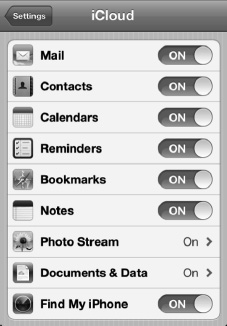
NOTE: At the time of writing, Photo Stream is an all-or-nothing service. If Photo Stream is turned on, Apple will keep 1000 of your most recent photos for up to 30 days on its servers, copying them to your iPad, Apple TV, Mac, or Windows PC. Anything logged into iCloud will get a copy of your Photo Stream. If you take photos of a sensitive or personal nature, you might want to set the Photo Stream option to Off.
Likewise, you can tap Documents and Data to toggle this option ON or OFF. You also have the option to set the Use Cellular option to ON. This will make sure your documents stay up to date even when you’re out and connected to a 3G data network.
NOTE: If you’re on a limited data plan or are roaming while traveling, then you might want to turn this feature off to avoid costly overage charges.
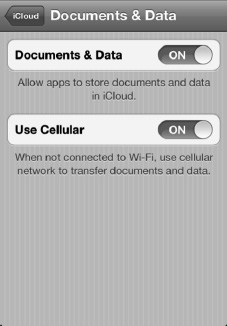
Managing iCloud Storage and Backup
iCloud comes with 5GB of free storage. Music from iTunes, apps, iBooks, and your Photo Stream don’t count against your 5GB, so most people will still have plenty of space left over for app data, documents, and backups.
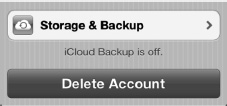
To check your iCloud Storage, scroll down to the bottom and tap Storage and Backup.

The Storage section shows you Total Storage, or the full size of your iCloud account; and Available Storage shows how much total storage you have left.
At the bottom of the screen, you can toggle iCloud Backup to ON or OFF.
NOTE: For most users, most of the time, we strongly recommend the iCloud Backup option be toggled to ON and left that way.
You can tap the Back Up Now button if you ever need to back up your iPhone immediately. You might do this if you want to reinstall your iPhone, switch to a replacement or new iPhone, or intend to go on a trip and want to make sure your phone is backed up before you leave.
To see how your iCloud storage is being used, tap Manage Storage.
At the top of the Manage Storage screen, you’ll see a list of devices currently backed up to iCloud. This will include your iPhone and any other iOS devices you might own, like an iPad or iPod touch.
Tap the device you want to look at and you’ll be taken to the Info screen, which shows when your Latest Backup took place and the Backup Size.
The Backup Options section lets you individually toggle different types of backups on or off, including the Camera Roll and any apps you might have installed that sync their settings or data with iCloud. This section also tells you how much storage each app is using.
Initially, you’ll only see a few apps. Tap See All Apps for the full list. Setting an app to OFF means you’ll save on storage space, but your data will no longer be synced between your iOS devices, nor will it be restored if you ever reinstall your device or the app.
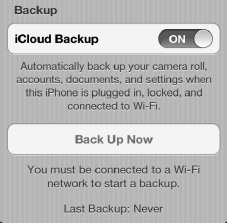
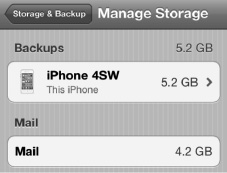
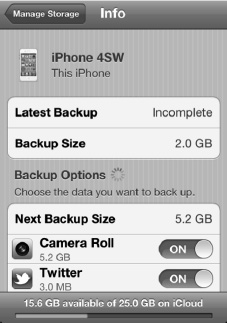
TIP: Your iPhone’s big, 8 megapixel, 1080p camera means that backing up the Camera Roll can quickly eat up a lot of storage, especially if you have only the free 5GB plan. The Photo Stream feature already backs up your photos; if backing up your video isn’t a concern, then you can toggle Camera Roll backups to OFF to save space.
Buying More iCloud Storage
You might find yourself constantly running out of iCloud storage, decide you want to start backing up more photos and videos, or discover you need to back up multiple iOS devices. If so, you can buy more iCloud Storage from Apple.
Simply tap any of the Buy More Storage buttons peppered throughout the iCloud’s Settings screens. At the time of writing, additional iCloud storage costs were as follows:
- 10GB for US $20/year
- 20GB for US $40/year
- 50GB for US $100/year
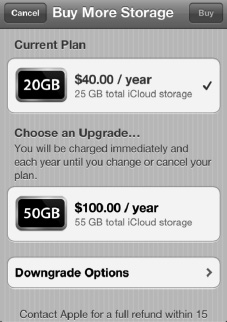
iTunes in the Cloud
iCloud also includes the iTunes in the Cloud feature, which lets you re-download previously purchased apps. In some countries, it even lets you re-download iBooks, music, and even TV shows. This means you can download them to your iPhone whenever you like, delete them when you no longer need them, and then re-download them again when you want them back.
To learn more about re-downloading files from iTunes, see Chapter 22: “iTunes on Your Device,” Chapter 23: “The Amazing App Store,” and Chapter 13: “iBooks and E-Books.”
You can also set up your iPhone to automatically download any new apps, iBooks, subscription Newsstand issues, music, and TV shows purchased on any device or computer associated with your iTunes account. If you buy a new song on your PC or a new app on your iPod touch, then that song or app will immediately download and show up on your iPhone, as well.
Follow these steps to turn on automatic downloads:
- Launch Settings.
- Tap Store.
- Toggle Music, Apps, and Books to ON.
- If you want to enable automatic downloads on 3G as well, then toggle Use Cellular Data to ON.
- If you want to enable automatic Newsstand subscription downloads, then toggle the switch next to the name of the newspaper or magazine to ON.
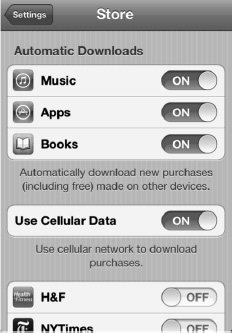
NOTE: At the time of writing, Apple’s 20MB download limit for 3G networks also applied to the iTunes in the Cloud feature. This means that, if you’re away from Wi-Fi, you won’t be able to automatically download or re-download any apps or files more than 20MB in size until you return to a Wi-Fi connection. This limitation applies to iBooks, music, TV shows, and so on.
iCloud on the Computer
iCloud doesn’t just sync your information between your iPhone and Apple’s servers or between your iOS devices. It can also sync information between your iPhone and your Windows or Mac PC.
If you’re a Windows user, you can turn syncing on or off for several apps and services in the iCloud Control Panel for Windows (see Figure 3–1). Apps and services you can sync with include Mail, Contacts, Calendars & Tasks, and Reminders, among others.
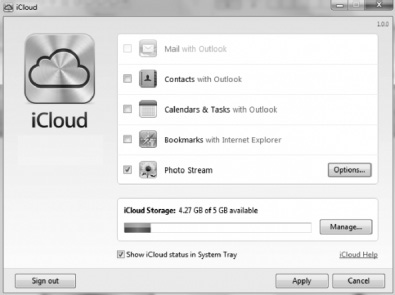
Figure 3–1. iCloud Control Panel for Windows
If you’re a Mac OS X user, you can turn these options on or off in the OS X 7.2 Lion iCloud Systems Settings panel (see Figure 3–2).
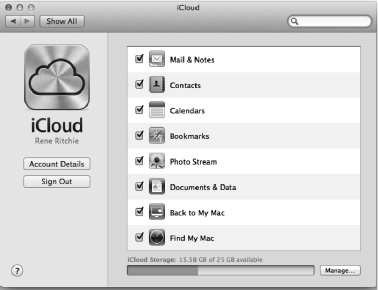
Figure 3–2. The Mac’s Lion iCloud Systems Settings panel (OS X 7.2)
Automatic app, books, music, and other downloads can be turned on or off in the iTunes app via the Store Preferences screen (see Figure 3–3).
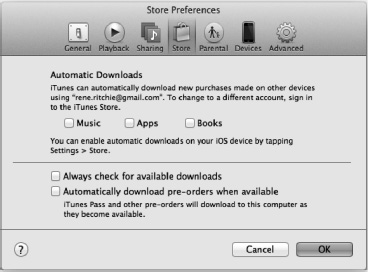
Figure 3–3. The iTunes’ Store Preferences screen
Syncing with iTunes
There are a few things you need before you can start using iTunes to sync. In the upcoming sections, we will cover the prerequisites and answer a few common questions about the reasons to use iTunes. We will also help you understand what happens if you own another Apple device, such as an iPad or iPod, and start syncing with your iPhone.
Prerequisites
There are just a few things you need to do before you sync your iPhone with iTunes:
TIP: If you followed all the steps in Chapter 1: “Getting Started,” chances are you’ve already completed the steps listed below and the initial sync of your contacts, calendar, bookmarks, notes, and email accounts to your iPhone. If so, you may want to skip ahead to the “Apps: Sync and Manage Them” section later in this chapter.
- Make sure you’ve installed version 10.5 or higher of the iTunes app on your computer. For help with installing or updating iTunes, see Chapter 22: “iTunes on Your Device.”
- Make sure you have your iTunes account ID handy. This is the email address and password you use to buy music, apps, and other content from iTunes.
- Get the white sync cable that came with your iPhone. One end plugs into the bottom of your iPhone near the Home button, and the other plugs into the USB port on your computer.
Syncing iTunes with an iPod or iPad and Your iPhone?
You might wonder whether you can sync iTunes with multiple devices, such as your iPod or iPad and your iPhone. Yes, you can! As long as you are syncing to the same computer, you can sync several Apple devices (Apple says up to five, but we’ve heard of people syncing more) to the same iTunes account on a single computer.
CAUTION: You can’t sync the same iPhone, iPad, or iPod to two different computers. If you attempt to do this, you’ll see a message like this: “Would you like to wipe this device (iPhone, iPad, iPod) and resync the new library?” If you answer Yes, any music and videos on the device will be erased.
There Are Other Sync Methods—Should I Use iTunes?
iCloud is both free and the easiest way to keep your iPhone in sync with your other devices, while iTunes is there to help you with large files, movies, and other content that iCloud doesn’t yet handle. You can also use other approaches to synchronize certain data, such as your personal information and email (including Exchange/Google). Keep in mind, however, that even if you choose one of these other approaches, you’ll still need to use iCloud and/or iTunes to accomplish the following:
- Back up and restore files and data on your iPhone
- Update the iPhone operating system software
- Sync and manage your applications (apps)
- Sync your music library and playlists
- Sync movies, TV shows, podcasts, and iTunes U content
- Sync books
- Sync photos
Table 3–1 summarizes your synchronization options. What method you choose to use for synchronization should be driven by where you currently store your email, contacts, and calendar; your environment; and whether you want to have a wireless sync.
NOTE: Some environments let you wirelessly sync your contacts and calendars to your iPhone.
Set Up Your iTunes Sync
Next, we will show you all the steps for using the iTunes app to perform both automated syncs and manual transfers of information to your iPhone.
The iPhone Summary Screen
The iPhone’s Summary tab in iTunes is where you see and update your version of your iPhone operating system software. It also contains an important switch related to syncing music, video, and other content. This tab is also where you can choose to automatically open iTunes (to sync) whenever you connect your iPhone to your computer.
Once you connect your iPhone to your computer, you can see important information, like your iPhone’s memory capacity, installed software version, and serial number (see Figure 3–4). You can also check for updates to the software version, restore data to your iPhone, and choose from the several options available on this screen.
In particular, you can decide whether you want to Manually manage music and videos using the checkbox at the bottom of this screen.
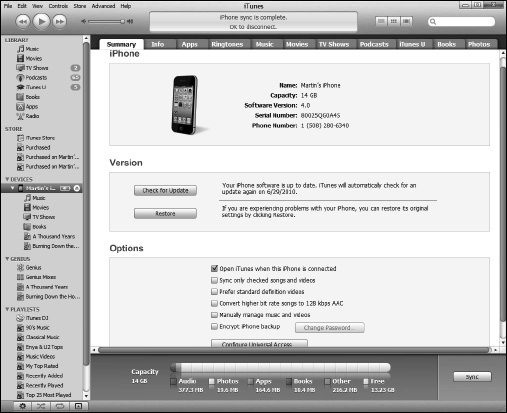
Figure 3–4. The iPhone’s Summary screen in iTunes
Follow these steps to see the Summary screen:
- Start the iTunes software on your computer.
- Connect your iPhone to your computer with the white USB cable supplied with the device. Plug one end into the bottom of the iPhone near the Home button and the other end into a USB port on your computer.
- If you’ve successfully connected your iPhone, you should see your iPhone listed under DEVICES in the left nav bar.
- Click your iPhone in the left nav bar, and then click the Summary tab on the top-left edge of the main window.
- If you want to be able to drag and drop music and videos onto your iPhone, check the box next to Manually manage music and videos.
- If you want to have iTunes open and sync your iPhone automatically whenever you connect it to your computer, check the box next to Open iTunes when this iPhone is connected.
TIP: Note that the iTunes software might not be installed on your primary computer (the one you use for syncing). For example, it might be installed on a second computer that you use for charging your iPhone. If so, you should check the box next to Manually manage music and videos and uncheck the box next to Open iTunes when this iPhone is connected.
Getting to the Sync Setup Screen (Info Tab)
Let’s assume you want to get to the Info tab, which is the setup screen for syncing your contacts, calendar, email, and so forth. To do so, you follow the same steps described previously for getting to the Summary screen, except now you click the Info tab at the top to see the Contacts (and other sync settings) in the main iTunes window (see Figure 3–5).
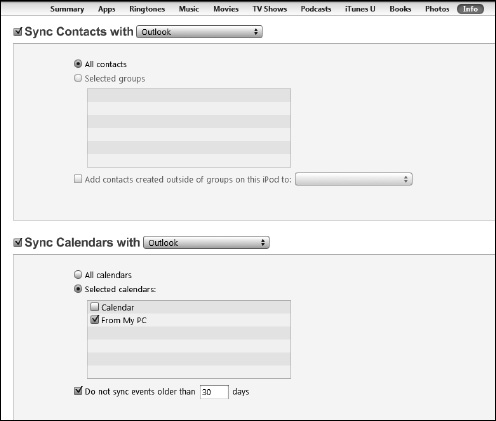
Figure 3–5. The iTunes’ Info tab, where you set up contacts, calendar, bookmarks, and more
Sync Your Contacts
Let’s start by setting up syncing for your contacts. The first step is to choose a service to sync with. To do so, check the box next to Sync Contacts with and adjust the pull-down menu to the software or service where your contacts are stored. At publication time, you have several syncing options on a Windows computer: Outlook, Google Contacts, Windows Contacts, and the Yahoo! Address Book.
CAUTION: Whenever you switch between a software or service (called the sync provider) in these sync settings screens, it affects every one of the mobile devices connected to your iTunes account. For example, if you sync contacts to your iPad or iPod touch, these changes will also affect MobileMe. You will be changing the way contacts sync for any other devices connected to your iTunes account.
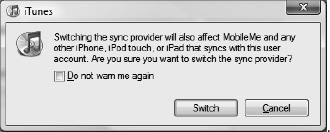 .
.
Syncing with Google Contacts
If you select Google Contacts, you’ll be prompted to enter your Google ID and password.
To change your Google ID or password, click the Configure button next to the Sync Contacts with option you saw at the top of this section.
Syncing with the Yahoo! Address Book
If you select Yahoo! Contacts, you’ll be prompted to enter your Yahoo! ID and password.
To change your Yahoo! ID or password, click the Configure button next to the Sync Contacts with option you saw at the top of this section.
NOTE: The options you see in this and other drop-down boxes on the Info tab will vary slightly, depending on the software installed on your computer. For example, on a Mac the contacts sync does not have a drop-down list; instead the other services, such as Google Contacts and Yahoo!, are shown as separate checkboxes.
Once you select a service or app to sync with, you’re ready to follow through on syncing your contacts:
- Select which contacts you will sync with from either of these options:
- All Contacts: Sync all contacts in your address book (this is the default).
- Selected Groups: Sync contacts only within specific groups that you check in the window below.
- You will see a checkbox that says Add contacts created outside of groups on this iPhone to(select a group from the drop-down list). This option lets you specify a new group for any new contacts you add on your iPhone that you don’t explicitly assign to a group.
- Scroll down the page to continue setting up your calendar, email, and more.
- If you don’t want to set up anything else for syncing, click the Apply button in the lower-right corner of the iTunes screen to start the sync.
NOTE: Depending on how many contacts you have, the initial sync could take longer than 10 minutes, and may even require 30 or more minutes. So you may want to do this sync when you can let your iPhone sit for as long as it takes (e.g., during lunch or after dinner).
Syncing Your Calendar
Syncing your calendar is similar to syncing your contacts. Follow these steps to do so:
- Within the same Info tab, scroll down to see the calendar sync set up.
- Check the box next to Sync Calendars with and adjust the pull-down menu to the software or service that stores your calendars. This might be Outlook or another application on a Windows computer, and iCal on a Mac.
- Select either of these options:
- All Calendars: Syncs all calendars (this is the default).
- Selected Calendars: Syncs only calendars you’ve checked in the window below.
- If you want to save space on your iPhone, click the checkbox next to Do not sync events older than 30 days. You can adjust the days up or down to fit your needs.
- Scroll down the page to continue setting up email accounts, bookmarks and more.
- If you don’t want to set up anything else for syncing, click the Apply button in the lower-right corner of the iTunes screen to start the sync.
NOTE: If you’re a Mac user who uses Microsoft Entourage, you’ll need to enable Entourage to sync with iCal. To do this, go into the Preferences settings in Entourage, and then go to Sync Services and check the boxes for synchronizing with iCal and the Address Book.
NOTE: At the time of writing, Entourage, unlike iCal, can’t handle multiple calendars.
Syncing Email Accounts
Scroll down the page to sync email account settings.
NOTE: After syncing the email account settings to your iPhone, you’ll still have to enter your password for each email account in Settings ![]() Mail, Contacts, Calendar. You have to do this only once on your iPhone for each account.
Mail, Contacts, Calendar. You have to do this only once on your iPhone for each account.
Follow these steps to do so:
- Scroll down below the Calendar settings on the same Info tab in iTunes to see the Mail account settings.
- Check the box next to Sync Mail Accounts from and adjust the pull-down menu to the software or service that stores your email (see Figure 3–6). This might be Outlook on a Windows computer, or Entourage or Mail on a Mac.
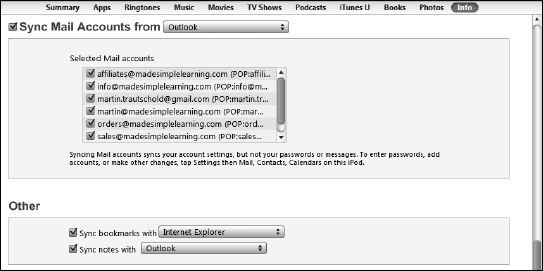
Figure 3–6. Setting up email accounts to sync
- Scroll down the page to continue setting up bookmarks, notes, and more.
- If you do not want to set anything else up for sync, then click the Apply button in the lower-right corner of the iTunes screen to start the sync.
Syncing Bookmarks and Notes
One great feature of the iTunes sync is that you can sync the browser bookmarks from your computer to your iPhone. This allows you to start browsing on your iPhone with all your favorite sites immediately. You can also sync your notes from your computer to your iPhone and keep them up-to-date in both places using iTunes.
NOTE: At the time of writing, iTunes supports only two web browsers for synchronization: Microsoft Internet Explorer and Apple Safari. If you use Mozilla Firefox or Google Chrome, you can still sync your bookmarks, but you’ll have to install free bookmark syncing software (such as xmarks from www.xmarks.com) to sync from Firefox or Chrome to Safari or Explorer. Once you install this software, you can sync your browser bookmarks in a simple, two-step process. Firefox’s Home app is a nice option for syncing bookmarks for Firefox users (visit http://itunes.apple.com/ca/app/firefox-home/id380366933?mt=8 for more information).
Syncing Your iPhone with iTunes
The syncing process is normally automatic when you plug in your iPhone to your computer’s USB port. The only exception is if you have disabled the automatic sync feature.
Sync Apps in iTunes
Follow these steps to sync and manage apps with the iTunes app:
- As you did to set up the sync previously, connect your iPhone to your computer, start iTunes, and click your iPhone in the left nav bar.
- Click the Apps tab on the top of the main window.
- Click the checkbox next to Sync Apps to see all apps stored on your iPhone and your Home screens, as shown in Figure 3–7.
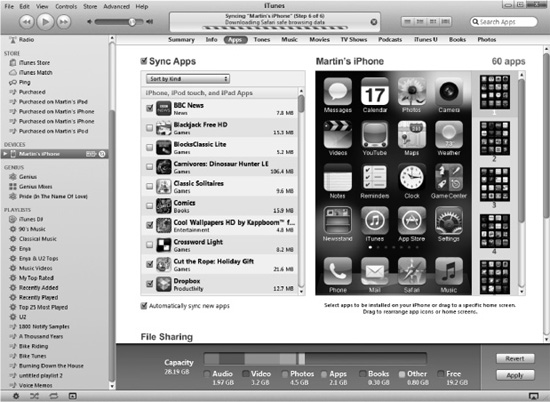
Figure 3–7. The Sync Apps screen in iTunes
Move Apps, Work with Folders, or Delete App Icons
It is very easy to move around and organize your application icons in iTunes’ Sync Apps screen (again, see Figure 3–7). Try these actions to accomplish various tasks:
- Move an app within a screen: Click it and drag it around the screen. If you want to select more than one app at a time, you can press and hold the Ctrl key (Windows) or Command key (Mac) and click to select.
- Move an app between Home screen pages: Click and drag it to the new page in the right column. The new page will expand in the main screen. Drop the icon onto the main screen.
- Dock an app on the bottom dock: Click and drag it down to drop it on the Bottom Dock. If there are already four icons on the bottom dock, you’ll need to drag one off to make room for the new icon. Only four icons are allowed.
- Create a new folder: Drag and drop one icon onto another icon.
- Move an app into an existing folder: Drag and drop the icon onto the Folder icon.
- Move an app out of a folder: Click the folder to open it. Next, drag and drop the icon outside of that folder.
- View another Home screen page: Click that page in the right column.
- Delete an app: Click it, and then click the little x in the upper-left corner. You can only delete apps you have installed. You won’t see an x on preinstalled apps like iTunes.
- Delete a folder: Remove all apps from that folder (drag them out) and it will disappear.
Removing or Reinstalling Apps
To remove an app from your iPhone, simply uncheck the box next to it and confirm your selection.
TIP: Even if you delete an app from your iPhone, you can still reinstall that app by rechecking the box next to it, as long as you have chosen to sync apps. The app will be reloaded onto your iPhone during the next sync.
Syncing Media and More
Now let’s look at how to set up an automatic sync for music, movies, iBooks, iTunes U content, and more.
CAUTION: Make sure you’re logged into iTunes with the same iTunes account you want to use on your iPhone as Digital Rights Management (DRM)-protected content (e.g., music, videos, and so on). Your content won’t sync unless both accounts match. You can logout and log into the iTunes service on both your desktop and your iPhone if you have to make sure you are logged into the right accounts.
Syncing Ringtones
When you click the Ringtones tab, you can choose to sync your entire ringtone library or selected items:
- Connect your iPhone to your computer, start iTunes, and click your iPhone in the left nav bar.
- Click the Ringtones tab at the top of the main window.
- Check the box next to Sync Ringtones,as shown to the right.
- The default is to sync All ringtones. To sync only specific ones, click the radio button next to Selected ringtones.
- When you are done with your selections, click the Apply button to start the ringtone sync.
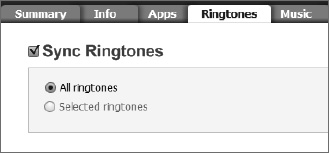
TIP: Learn how to assign ringtones to your contacts, purchase custom ringtones, and create your own ringtones from your music in Chapter 9: “Using the Phone.”
Syncing Music
When you click the Music tab, you can choose to sync your entire music library or selected items.
CAUTION: If you have manually transferred some music, music videos, or voice memos to your iPhone already, you’ll receive a warning message that all existing content on your iPhone will be removed and replaced with the selected music library from your computer.
To sync music from your computer to your iPhone, follow these steps:
- Connect your iPhone to your computer, start iTunes, and click your iPhone in the left nav bar.
- Click the Music tab on the top of the main window.
- Check the box next to Sync Music.
- Click next to Entire music library only if you are sure your music library will not be too large for your iPhone.
- Click next to Selected playlists, artists, and genres if you are unsure whether your music library is too large, or if you want to sync only specific playlists or artists:
- You can choose whether to include music videos and voice memos by checking those boxes.
- You can also automatically fill free space with songs.
CAUTION: We don’t recommend checking this option because it will take up all the space in your iPhone and leave no room for all those cool apps!
- Now check off any of the playlists or artists in the two columns on the bottom of the screen. You can even use the Search box at the top of the Artists column to search for particular artists.
- When you are done with your selections, click the Apply button to start the music sync.
Syncing Movies
When you click the Movies tab, you can choose to sync specific, recent, or unwatched movies—or all of them.
To sync movies from your computer to your iPhone, follow these steps:
- Connect your iPhone to your computer, start iTunes, and click your iPhone in the left nav bar.
- Click the Movies tab on the top of the main window.
- Check the box next to Sync Movies (see Figure 3–8).
- If you’d like to sync recent or unwatched movies, check the box next to Automatically include and use the pull-down menu to select All, 1 most recent, All unwatched, 5 most recent unwatched, and so on.
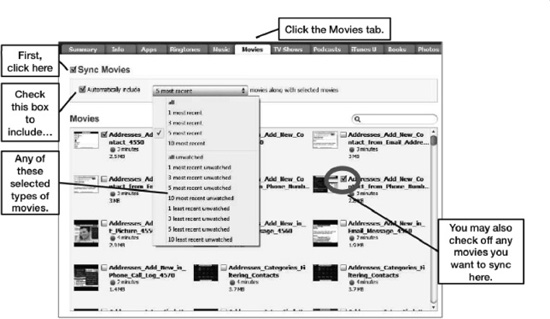
Figure 3–8. Configuring the Movies tab to automatically sync selections
- If you selected any item besides All, you have the choice to sync specific movies or videos to your iPhone. Simply check the boxes next to the movies you want to include in the sync.
- When you are done choosing movies, click the Apply button to save your settings and start the sync.
Syncing TV Shows
When you click the TV Shows tab, you can choose to sync specific, recent, or unwatched TV shows—or all of them.
To sync TV shows from your computer to your iPhone, follow these steps:
- Connect your iPhone to your computer, start iTunes, and click your iPhone in the left nav bar.
- Click the TV Shows tab on the top of the main window.
- Check the box next to Sync TV Shows.
- If you’d like to sync recent or unwatched TV shows, check the box next to Automatically include and use the pull-down menu to select All, 1 newest, All unwatched, 5 oldest unwatched, 10 newest unwatched, and so on.
- Choose All Shows or Selected Shows next to episodes of.
- If you choose Selected Shows, you can choose individual shows and even individual episodes in the two sections in the middle of the screen.
- If you have playlists of TV shows, you can select those for inclusion by checking the boxes in the bottom section of the screen.
- When you are done choosing individual TV shows, click the Apply button to save your settings and start the sync.
Syncing Podcasts
When you click the Podcasts tab, you can choose to sync specific, recent, or unplayed podcasts—or all of them.
TIP: Podcasts are audio or video shows that are usually regularly scheduled (e.g., daily, weekly, or monthly). Most are free to subscribe to in the iTunes Store. When you subscribe and set up the auto sync as shown in this section, you’ll receive all your favorite podcasts on your iPhone.
Many of your favorite radio shows are recorded and broadcast as podcasts. We encourage you to check out the Podcast section of the iTunes Store to see what might interest you. You’ll find podcasts of movie reviews, news shows, law school test reviews, game shows, old radio shows, educational content, and much more.
To sync podcasts from your computer to your iPhone, follow these steps.
- Connect your iPhone to your computer, start iTunes, and click your iPhone in the left nav bar.
- Click the Podcasts tab on the top of the main window.
- Check the box next to Sync Podcasts.
- If you’d like to sync recent or unplayed podcasts, check the box next to Automatically include and use the pull-down menu to select All, 1 newest, All unplayed, 5 newest, 10 most recent unplayed, and so on.
- Choose All Podcasts or Selected Podcasts next to episodes of.
- If you choose Selected Podcasts, you can choose individual podcasts and even individual episodes in the two sections in the middle of the screen.
- If you have playlists of podcasts, you can select those for inclusion by checking the boxes in the bottom section of the screen.
- When you are done choosing podcasts, click the Apply button to save your settings and start the sync.
TIP: After you sync these podcasts, you can enjoy them by navigating to the Podcasts section of the Music app on your device.
Syncing iBooks and Audiobooks
When you click the Books tab, you can choose to sync all or selected books and audiobooks.
TIP: Books on the iPhone are electronic versions of their paper cousins. They are in a specific electronic format called ePub. You can buy them in the iBookstore on the iPhone or acquire them from other locations and sync them to your iPhone using the steps described here. Books you acquire elsewhere must be unprotected or “DRM-free” in order to sync them to your iPhone. You read these books in the iBooks app or in other book reader apps on your iPhone. See Chapter 13: “iBooks and E-Books” to learn more.
To sync books or audiobooks between your computer and your iPhone, follow these steps:
- Connect your iPhone to your computer, start iTunes, and click your iPhone in the left nav bar.
- Click the Books tab on the top of the main window.
- Check the boxes next to Sync Books and Sync Audiobooks.
- If you’d like to sync all books, leave the default All books selection unchanged.
- Otherwise, choose Selected books and make your choices by checking specific books in the window.
TIP: In order to sync iBooks, PDF files, and other, similar documents to your iPhone, you need to first drag and drop your file from your computer into your iTunes library. Grab the file from any folder on your computer and drag and drop it right onto your library in the upper-left column in iTunes.
- If you would like to sync all audiobooks, leave the default All audiobooks selection unchanged.
- Otherwise, choose Selected audiobooks and make your choices by checking off specific audiobooks in the window below this selection item.
- When you are done choosing individual books and audiobooks, click the Apply button to save your settings and start the sync.
TIP: After you sync these books, you can enjoy them in the iBooks app on your device. You can listen to audiobooks in the Music app, where the Audiobooks tab is on the left side.
NOTE: Audiobooks from Audible require that you first authorize your computer with your Audible account before you can sync them to your iPhone from your computer.
Sync Photos
When you click the Photos tab, you can choose to sync photos from all folders or selected folders, and you can even include videos.
TIP: You can create a beautiful electronic picture frame and share your photos on the iPhone’s stunning screen (see Chapter: 20: “Working with Photos”). You can even use your photos to set the background wallpaper and screen-lock wallpaper—see Chapter 8: “Personalize and Secure” for more information.
To sync photos from your computer to your iPhone, follow these steps:
- Connect your iPhone to your computer, start iTunes, and click your iPhone in the left nav bar.
TIP: Mac users can also sync photos using various criteria in iPhoto, including Events (time-based sync), Faces (person-based sync), and Places (location-based sync).
- Click the Photos tab on the top of the main window.
- Check the box next to Sync Photos from.
- Click the pull-down menu next to Sync Photos from and select a folder from your computer where your photos are stored. If you want to grab all your photos, go to the highest folder level possible (e.g., C: on your Windows computer or your hard disk root directory “/” on your Apple Mac).
- If you’d like to sync all photos from the selected folder on your computer, select All folders.
CAUTION: Because your photo library on your computer may be too large to fit on your iPhone, be careful about checking All folders.
- Otherwise, choose Selected folders and make your choices by checking specific folders in the window below.
- You can also include any videos in the folders by checking the box next to Include videos.
- When you are done choosing your photos to sync, click the Apply button to save your settings and start the sync.
- When the sync starts, you’ll see the status in the middle-top status window in iTunes.
Troubleshooting iTunes and the Sync
Sometimes iTunes does not behave exactly as you’d expect it to, so here are a few simple troubleshooting tips.
Check Out the Apple Knowledgebase for Helpful Articles
The first step when you’re having a problem is to check out Apple’s support pages, where you’ll find lots of helpful information. On your iPhone or computer’s web browser, go to this web page:
www.apple.com/support/iPhone/
Next, click a topic shown in the left nav bar.
iTunes Locked Up and Will Not Respond (Windows Computer)
Sometimes, iTunes will lock up and be completely unresponsive. Follow these steps if this happens on a Windows computer:
- Bring up the Windows Task Manager by simultaneously pressing Ctrl + Alt + Del keys on your keyboard. The Task Manager should look something like Figure 3–9.
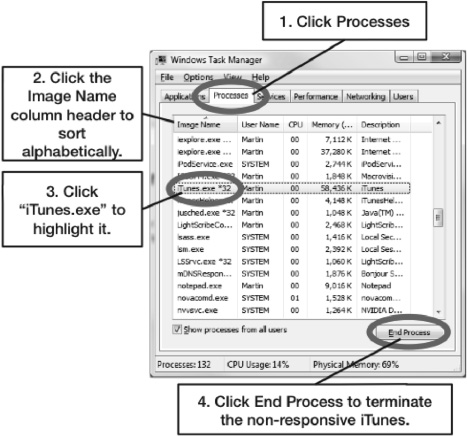
Figure 3–9. Locating
iTunes.exein the Windows Task Manager, so you can terminate it - To end the process, click End process from the pop-up window.
- Now, iTunes should be forced to close.
- Try restarting iTunes.
- If iTunes will not start or locks up again, then reboot your computer and try again.
iTunes Locked Up and Will Not Respond (Mac Computer)
If you’re using a Mac, then follow these steps if the iTunes app locks up and is completely unresponsive:
TIP: Pressing Command + Option + Escape is the shortcut to bring up the Force Quit Applications window (see Figure 3–10).
- Click the iTunes menu at the top.
- Click Quit iTunes.
- If that doesn’t work, go to any other program and click the small Apple logo in the upper left corner of your Mac.
Click Force Quit and the list of running programs will be displayed.
4.
5. Highlight iTunes and click the Force Quit button.
6. If this does not help, try restarting your Mac.
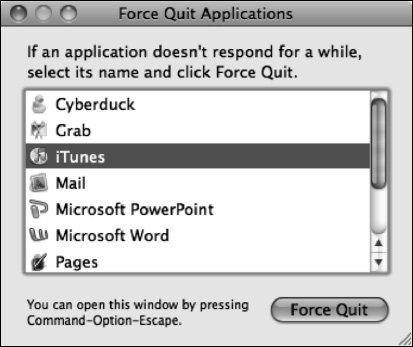
Figure 3–10. The Force Quit Applications window on Mac computers
Updating Your iPhone Operating System
With iOS5 you can now update your iPhone operating system on-device. There are faster, more efficient update methods for doing this, and we recommend you use them whenever possible. If you need to re-install the entire OS, however, or want to upgrade via iTunes instead, this section will explain how to do so.
NOTE: Do this update when you won’t mind being without your iPhone for 30 minutes or more, depending on the amount of information on your iPhone and the speed of your computer and Internet connection.
Normally, iTunes will automatically check for updates on a set schedule, about every two weeks. If no update is found, iTunes will tell you when it will check for another update. Follow these steps to use iTunes to manually update your iPhone:
- Start iTunes.
- Connect your iPhone to your computer.
- Click your iPhone listed under DEVICES in the left nav bar.
- Click the Summary tab in the top nav bar.
- Click the Check for Update button in the center of the screen in the Version section.
- If you have the latest version, you’ll see a pop-up window saying something like this: “This version of the iPhone software (5.0) is the current version.” Click OK to close the window. You are done with the update process.
- If you don’t have the latest version of iTunes, a window will tell you a new version is available and ask if you would like to update. Click Yes or Update to do so.
- iTunes will take you through a few screens that describe the update and ask you to agree to the software license. If you agree, click Next and Agree to download the latest iOS software from Apple. This will take about five to ten minutes.
TIP: We show you all the screens you might see in this update process in the “Reinstalling the iPhone Operating System” section of Chapter 26: “Troubleshooting.”
- Next, iTunes will back up your iPhone, a process that might take ten minutes or more if your iPhone is filled with data.
- Now the new iOS will be installed, and your iPhone will be erased.
- Finally, you’ll be shown a screen asking you to do one of the following:
- Set up as a new iPhone: Choose this if you want to erase all your data after the update process.
- Restore from the backup of: Choose this to make sure you select the correct backup file (usually the most recent one).
At this point, your iPhone will be restored or set up as selected.
- If you have locked your SIM card, then you will need to enter the four-digit PIN code required to unlock it.
CAUTION: If you have locked your SIM card, then you will need to enter the four-digit unlock code after the update is installed. If you’ve forgotten the SIM unlock code, then you can use the PUK code to unlock the SIM (you need to get that from your wireless carrier). See the “Setting Security on Your SIM Card” section in Chapter 9: “Using the Phone” for more information.
- Your iPhone OS update is complete.
Other Sync Methods
You can navigate to the Mail, Contacts, Calendar app in your Settings app on your iPhone to set up and use Exchange. The next section will explain how to do so.
Setting Up Your Google or Exchange Account on Your Device
Use the following steps to set up the wireless sync for either your Exchange account or your Google contacts and calendar:
- Touch the Settings icon.
- Touch Mail, Contacts, Calendar.
- You’ll see a list of your email accounts and, below that, the Add Account option.
If you have no accounts set up, you will see only Add Account. In either case, tap Add Account.
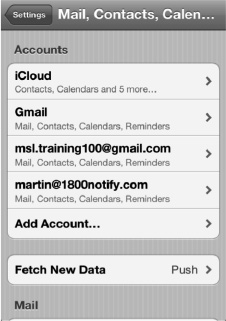
- On the next screen, choose Microsoft Exchange.
NOTE: You should choose Microsoft Exchange if you want to have the wireless sync with your Google Contacts and Calendar. If you select Gmail, you will not be able to sync wirelessly with your Google Contacts.
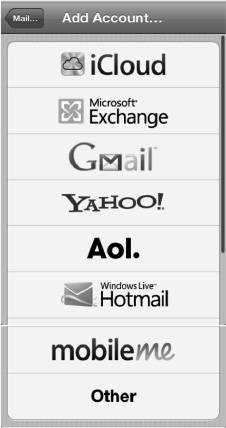
- Type your email address.
TIP: To type the
.com(or.net,.edu,.org, etc.) in the email address, press and hold the Period (.) key until you see the .com key appear above it. Slide over and press .com.

TIP: Since your email address is also usually your username, save yourself some time by copying and pasting it.
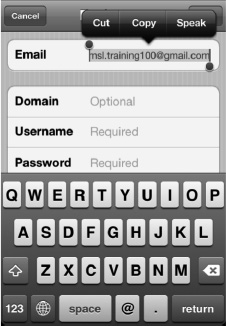
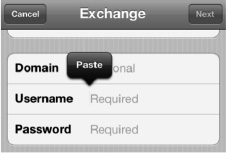
- Copy and paste your email address into the Username field (This works well when your username is the same as your email or if it is the same as the first part of your email address before the @ sign):
- Touch and hold the Email field, then lift your finger to see the black pop-up appear above it.
- Tap Select All.
- Tap Copy.
- Touch and hold the Username field, then lift your finger to see the pop-up appear. Tap Paste.
- Leave the Domain blank. Type your Password. If you want, you can adjust the Description of the account, which defaults to your email address.
- Tap the Next button in the upper-right corner.
- You may see an Unable to Verify Certificate dialog. If you do see it, click Accept to continue.
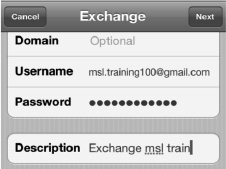
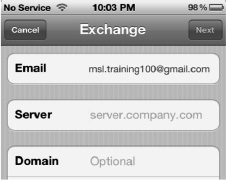

- In the Server field, type m.google.com to sync to Google. Otherwise, if you are setting up your Exchange Server account, enter that server address.
- Click Next in the upper-right corner.
- On this screen you have the option to set the wireless sync for Mail, Contacts, and Calendars to ON or OFF. For each sync you’d like to turn on, tap the switch to change it to ON.

NOTE: If you already have contacts or calendar items on your iPhone, you may see some warnings appear. Your choices are to Keep on My iPhone or Delete. If you choose Cancel, your iPhone stops setting up your Exchange account. Select Keep on My iPhone to keep all existing contacts and calendar events on your iPhone. These items will not end up on your Exchange account—they will stay on your iPhone.

